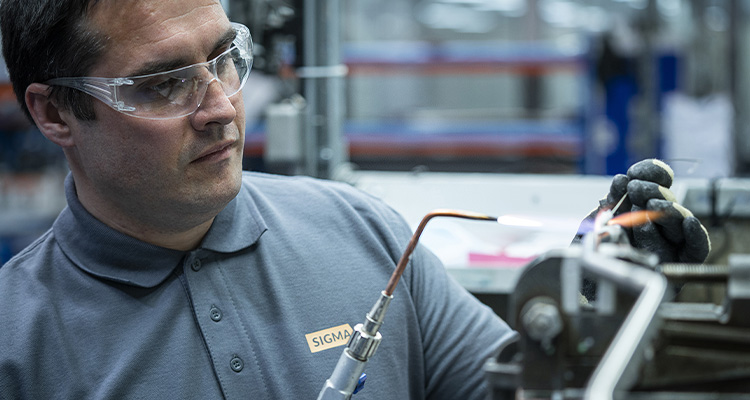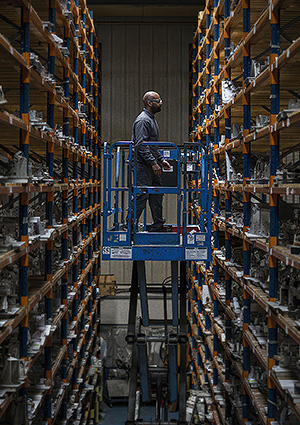
A leading manufacturer of precision engineered aerospace products, Sigma supplies parts and services to civil and military aircraft platforms
Sigma is a leading supplier of engineered aerospace products, primarily metallic pipes, tubes, ducts and fabricated parts. The company employs 475 people across four locations in the UK and China, and its customers include many well-known Tier 1 companies as well as OEMs in the aerospace industry. Sigma’s business is focused on commercial aerospace, supporting most of the major Airbus and Boeing commercial aircraft platforms. Founded in 2004, initial operations focused on China but have since expanded into the UK through several add-on acquisitions.
“The business makes about 40,000 machined parts and fabricates around 30,000 pipes per month,” Richard Bower, CEO, begins. “Our products are primarily fabricated from stainless steel, Inconel, titanium and aluminum and key processes are bending, forming, machining, polishing, brazing, welding and a variety of NDT testing, surface treatment and heat treatment processes. We are AS 9100 REV D and Nadcap approved for special processes as well as holding a wide variety of customer-specific approvals.”

Steady growth
As a business focused on commercial aviation, Sigma was significantly impacted by the pandemic as the supply chains serving the aircraft OEMs ground to a halt overnight. “2020 was the start of the problem,” Richard shares, “and we reacted in the same way as many suppliers in the sector and had to trim our capacity, cut costs, and preserve cash. We felt we had to be aggressive in doing this as there was so much uncertainty during 2020 and 2021. We all believed that the underlying demand would always be there for commercial air travel, it was just a case of when it would come back. We had to make sure we preserved a viable business for when the recovery came.”
Since 2021, Sigma has grown steadily, as supply chains and OEM build rates have recovered but as was the case for many other suppliers, the company was challenged in terms of material prices and availability and the ability to simply recruit the right people to support the returning demand. “A lot of skilled people were taken out of the industry at the height of the pandemic and then suddenly the whole sector was looking to recruit skilled people to support the ramp-up and it’s probably only in the last 18 months or so that things have got a little easier in that respect.
“Alongside this, we have also worked very hard to acquire new business and secure new customers, but we have stuck to the aerospace sector as that’s what we are good at. We are happy with where we are now as activity in the sector has recovered to pre-pandemic levels and beyond in some cases and the outlook is very positive but ultimately, the whole industry has missed out on four-to-five years’ growth,” he explains.
Three segments
Sigma’s business is segmented into three parts. As the name suggests, the Airframe segment comprises parts that go on to a variety of aircraft airframes, servicing both the defense and civil aviation sectors. “The parts are quite varied,” Richard adds, “requiring bending, pressing, fabrication and a fair degree of hand-working as well as a variety of heat and surface treatments. Airframe represents around 30 percent of Sigma’s business today and we supply products to Airbus A220, Airbus A350, Business Jet and some military aircraft.
“Our second segment is Power & Systems. This is defined as any product that we are supplying for fitment to the aircraft engine or engine nacelle. Power & Systems is about 60 percent of our business and is almost all supplied into the commercial aviation market, supporting engines on Airbus A320, A350 and Boeing 737 amongst others.
Specialist skills 
“The third facet is Services which is primarily the polishing of blades and vanes for the engine OEMs as well as a small amount of NDT and testing services. The Services segment is quite different to the other parts of Sigma’s business in that it’s a fast turnaround of customers’ own parts as opposed to a process of converting raw materials into a finished product. It represents around ten percent of our turnover and processes product for a broad range of aircraft engines.”
Sigma operates out of four sites: three in the UK and one in Chengdu, China. “The Hinckley site employs around 150 people and is our center of excellence for bending and fabrication of rigid pipes. Chengdu is one of Hinckley’s biggest suppliers, sending thousands of detailed parts and machined fittings per month that Hinckley will combine with bent tube to make finished parts for customers. The Farnborough site employs 75 people and is more focused on our airframe business. There is a core of specialist fabrication skills at Farnborough due to the nature of the products that are unique to the site.
“Our third site in the UK is Sandiacre, just outside Nottingham,” Richard continues. “Our Sandiacre site polishes blades and vanes for engine OEMs on a fast-turnaround basis. The site employs 50 people, 40 of whom are skilled polishers. Chengdu in China is a key part of our supply chain, has close to 50 machining centers and employs 175 people. Our Chengdu site is one of our differentiators in that we own the business, and it offers a reliable low-cost supply chain solution to our business in the UK and is also able to offer finished parts directly to our customers.”
Customer confidence
Bending is recognized as one of Sigma’s core capabilities and once fully recovered, post-pandemic, it made sense to invest in the latest equipment. “We have invested in three new benders to cover a range of tube diameters and materials that are all running identical software and have common processes and training requirements. We have specified the machines to cover our current requirements but also cater for what we see as future opportunities that we would not be able to access with our old machinery. The machines will enhance our capability for some of the larger diameters in the tougher materials and crucially will give us confidence that we can deliver products quickly and in a reproduceable way,” he enthuses.
“We are a ‘build to print’ supplier, which means that the design authority of all the parts we make rests with the customer and our obligation is to make parts that conform to the customer’s design and drawing. As such, our innovation focuses on the best way of producing the customer-defined product; be it the way we design the manufacturing route, the use of modular tooling or fixtures and innovative processes to eliminate waste or reduce lead time.”
The company has recently had all its sites surveyed to assess any environmental impact and implemented recommendations for improvement. For example, it recently worked with a customer to allow shipment of multiple products within a single container, rather than one package per product, delivering a significant reduction in shipping materials. Many of Sigma’s products are sensitive to handling and even changes to the packaging need to be carefully planned and implemented.
“Clearly,” Richard adds, “the issue is much broader than addressing things internally and we have a whole supply chain both behind and in front of us that is working to reduce the environmental impact of the industry. Some of our customers are quite advanced in assessing the carbon footprint of their activities and are requiring us to do the same.”
Indeed, Sigma has long term relationships with many of its customers and as a trusted supplier, the team works hard to maintain its relationships with them. “Long-term customer relationships are the key to success and it’s very difficult to develop and grow without them. It’s all about our customers’ confidence in our ability to deliver. We also have good relationships with our key material suppliers and sub-contract processors. There are only a limited number of suppliers that we can use for our main raw materials and it’s a different dynamic to our customer relationships but boils down to the same thing in the end,” he explains.
“Backlogs at Boeing and Airbus are close to all-time highs and our order books for components for those and other OEMs’ aircraft are growing. As such, we are investing in capacity and people to meet the demand. Of course, there are a few clouds on the horizon in terms of the geo-political outlook and we are facing some increased employment costs as we go into the year, so we are always looking at how we can improve our operations, be that through investment or improvements in process.
“One of the big advantages of serving the commercial aviation market is the long-term view that it gives you in terms of demand. We can see what we have ahead of us in detail for the next 12 months and more generally for a couple of years beyond that. Executing well on what we have in front of us relies on our integrated supply chain and our chosen suppliers. That’s what makes us successful in the end.
“Over the next five years, we are looking to grow and diversify our customer base, to cover as much of the market as possible,” Richard concludes. “Our vision is ‘to be the supplier and partner of choice in everything we do. On every engine, every airframe’. We do support a significant proportion of the aviation sector already but there are some customers where we’d like to be a much bigger supply partner. We’ll be very much sticking to what we are good at, with continued focus on our three key markets and we believe we can broadly double the size of our business in the next five years.”
